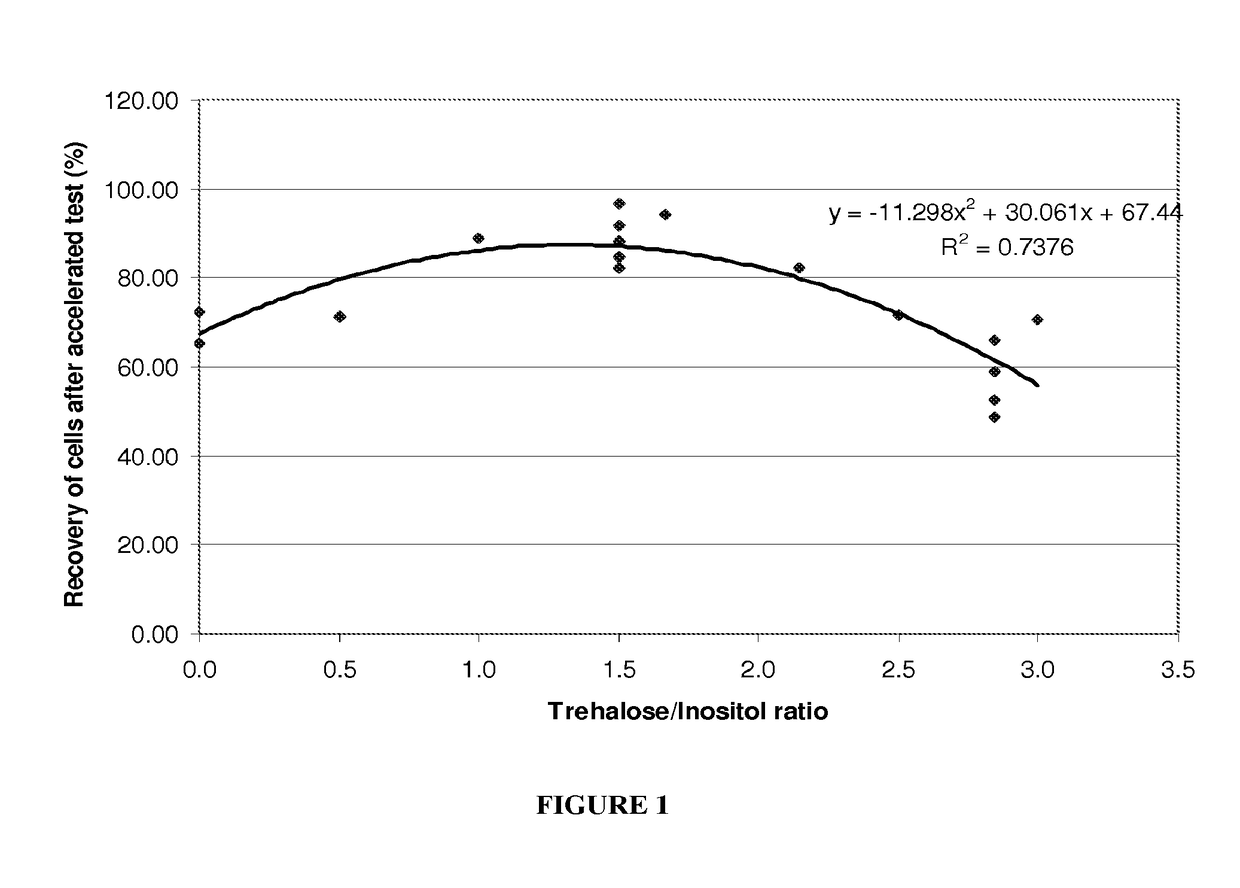Cryoprotective compositions and uses thereof
a composition and cryoprotective technology, applied in the field of cryoprotective compositions, can solve the problems of significant loss of activity and viability, difficult manufacturing of food or feedstuffs with living materials, and loss of viability or activity of most biological materials or active molecules, so as to increase viability and/or preserve activity
- Summary
- Abstract
- Description
- Claims
- Application Information
AI Technical Summary
Benefits of technology
Problems solved by technology
Method used
Image
Examples
example 1
[0097]Various cryoprotectants (see table 1) were mixed in a suspension containing, Lactobacillus acidophilus at an approximate cell count of 1E11 CFU / gr. The mixture, called stabilized concentrate, was kept at 4-8° C. for 1.5 hrs and continuously agitated before being frozen by dispensing droplets of the stabilized concentrate into liquid nitrogen. The resulting frozen droplets are called frozen pellets.
TABLE 1Formulation of Trehalose based cryoprotectant tested on a suspension ofLactobacillus acidophilus.TrehaloseconcentrationAdditional cryoprotective(% W / W ofcomponentstabilized(% W / W of stabilizedCryoprotective solutionconcentrate)concentrate)Trehalose alone experiment 180Trehalose alone experiment 2140Trehalose with phosphate131 as KHP04Trehalose with EDTA140.0021 as EDTAInositol alone016.7 as InositolTrehalose with Inositol143.4 as Inositolexperiment 1Trehalose with Inositol136.7 as Inositolexperiment 2Trehalose with Inosine Mono143.4 as IMPPhosphate (IMP)
[0098]The frozen pellet...
example 2
[0101]Various ratio of Inositol over Trehalose have been tested. The cryoprotectants were mixed for 1 to 3 hrs at 10-30° C. to a suspension containing Lactobacillus acidophilus at an approximate cell count of 1E11 CFU / gr. The mixture was frozen and freeze dried, and a cell count was performed just after freeze drying by performing an accelerated stability test, as disclosed in Example 1. Table 3 gives the results of this testing.
TABLE 3Cell counts and accelerated stability results for Trehalose based cryoprotectanttested on a suspension of L. acidophilus including Trehalose to Inositolratio and percent recovery of cells after accelerated stability testing.TrehaloseInositolRecovery ofViable cellRecovery ofconcentrationconcentrationViable cellviable cell fromcounts afterviable cells after(% W / W of(% W / W ofRatiocounts afterfrozen pellets toacceleratedacceleratedstabilizedstabilizedTrehalose / freeze dryingfreeze dried pelletsstability teststability testconcentrate)concentrate)Inositol(CF...
example 3
[0103]Cryoprotectants made of Inositol with non reducing sugar such as Trehalose or Sucrose were mixed with a suspension of Bifidobacterium lactis at an approximate cell count of 1E11 CFU / gr. The mixture called stabilized concentrate was kept at 4° C. and continuously agitated before being frozen by dispensing droplets of the stabilized concentrate into liquid nitrogen. The resulting frozen droplets are called pellets. The frozen pellets have then been freeze dried in a Virtis® freeze drier under a vacuum at 100 mT. The freeze dried pellets were evaluated by measuring the cells counts just after freeze drying and by performing an accelerated stability test. In addition, the recovery of cells from the frozen pellets to freeze dried pellets was calculated. Tables 4 and 5 give the results of the test.
TABLE 4Comparison of recovery after freeze drying andrecovery after an accelerated stability test for acryoprotectant containing Trehalose and Inositol.Non-Recovery ofRecovery ofreducingIn...
PUM
| Property | Measurement | Unit |
|---|---|---|
| temperature | aaaaa | aaaaa |
| concentration | aaaaa | aaaaa |
| temperature | aaaaa | aaaaa |
Abstract
Description
Claims
Application Information
 Login to View More
Login to View More - R&D
- Intellectual Property
- Life Sciences
- Materials
- Tech Scout
- Unparalleled Data Quality
- Higher Quality Content
- 60% Fewer Hallucinations
Browse by: Latest US Patents, China's latest patents, Technical Efficacy Thesaurus, Application Domain, Technology Topic, Popular Technical Reports.
© 2025 PatSnap. All rights reserved.Legal|Privacy policy|Modern Slavery Act Transparency Statement|Sitemap|About US| Contact US: help@patsnap.com

